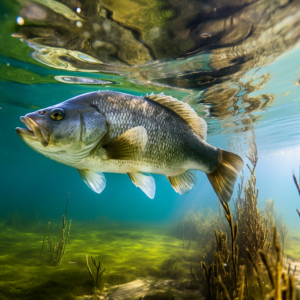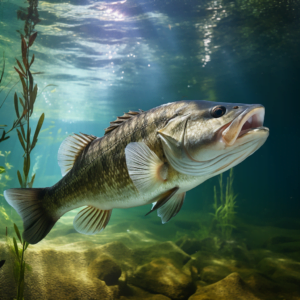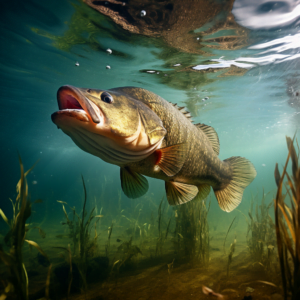When it comes to bass fishing, have you ever wondered which species of bass is the most aggressive? Whether you’re an avid angler or just starting out, understanding the behavior of different bass species can greatly improve your chances of a successful catch. In this article, we will delve into the world of bass fishing and explore which bass species is known for its aggression. By the end, you’ll have a better understanding of the behaviors of different bass species and how to optimize your fishing techniques accordingly.
Bass, a type of freshwater fish, are known for their strength and fighting ability, making them a popular target for anglers. Among the various bass species, such as largemouth bass, smallmouth bass, and spotted bass, there is often a debate about which one is the most aggressive. While bass aggression can vary depending on factors such as habitat and environmental conditions, experts generally agree that the smallmouth bass is the most aggressive of the three common bass species.
Smallmouth bass, also known as bronzebacks, are known for their tenacity and willingness to strike at a bait or lure. They are aggressive feeders and are notorious for putting up a strong fight once hooked. This species of bass is renowned for its athleticism and ability to leap out of the water, providing an exhilarating fishing experience. Despite their small size compared to largemouth bass, their aggressive nature makes them a prime target for anglers looking for an exciting challenge.
In conclusion, when it comes to aggressiveness, the smallmouth bass reigns supreme among bass species. Their tenacity and willingness to strike make them a challenging and thrilling catch for any angler. By understanding the behavior and habits of different bass species, you can tailor your fishing techniques to maximize your chances of success. So, whether you’re a seasoned pro or just starting out, keep in mind the aggressive nature of smallmouth bass the next time you head out on the water.
Introduction
When it comes to the art of angling, the thrill of the chase and the fight to reel in a formidable opponent is what makes bass fishing one of the most popular recreational activities worldwide. Bass, known for their strength and tenacity, have earned a reputation for their aggressive nature. But which bass species truly takes the crown as the most aggressive? In this article, we will explore the physical attributes, behavioral patterns, and predatory habits of different bass species to determine which one reigns supreme in the realm of aggression.
Defining aggressiveness in bass
Physical attributes
Aggressiveness in bass can often be attributed to their physical attributes. The size and strength of their bodies play a significant role in their ability to assert dominance and compete for limited resources. Largemouth bass, smallmouth bass, and spotted bass are three popular contenders in this regard.
Behavioral patterns
Apart from physical attributes, behavioral patterns also contribute to the overall aggressive nature of bass. Territorial behavior, feeding habits, and even spawning behavior can vary across species, ultimately influencing their level of aggression.
Largemouth bass: A top contender
Distinct physical features
Largemouth bass, also known as black bass or bigmouth bass, are easily recognizable due to their large mouth and elongated body. Their powerful jaws and broad heads allow them to consume prey that is up to half of their body length. This distinct physical feature alone grants them an advantage in the aggressive behavior department.
Territorial behavior
Largemouth bass are notoriously territorial, often defending their preferred hunting grounds and breeding areas with great ferocity. They establish dominance through aggressive displays and physical confrontations, making them a formidable opponent when it comes to aggression among bass species.
Feeding habits
Largemouth bass are opportunistic predators, exhibiting a voracious appetite for a wide variety of prey. Their ability to ambush, pursue, and strike their prey with remarkable speed and precision further enhances their aggressive nature. This relentless pursuit of food drives their territorial behavior and contributes to their overall aggressiveness.
Smallmouth bass: A fierce competitor
Physical characteristics
Smallmouth bass, often found in cooler and clearer waters, possess distinct physical features that make them formidable contenders in the aggressiveness department. Their strong jaw structure and sharp teeth allow them to feed on a diet of crayfish and small baitfish.
Aggressive spawning behavior
During the breeding season, smallmouth bass display intense territoriality and aggression, especially among males vying for the attention of females. They fiercely guard their nests and will attack any intruders that come too close. This aggressive spawning behavior is a testament to their competitive nature.
Incredible fighting skills
Smallmouth bass are known for their incredible fighting skills, often putting up a spirited battle when hooked. Their strength and endurance, combined with sharp tactics such as jumping and diving, make them an angler’s favorite opponent. This formidable fighting ability is a result of their innate aggression and adds to their overall reputation as a fierce competitor.
Spotted bass: A force to be reckoned with
Distinctive traits
Spotted bass, also known as Kentucky bass, possess distinctive traits that contribute to their aggressive nature. They have a relatively small mouth compared to largemouth bass but compensate for it with a more streamlined body shape, allowing them to chase down prey with agility.
Feeding aggression
Spotted bass exhibit feeding aggression, often hunting in groups and competing for food resources. They are known to aggressively strike at baitfish, insects, and crayfish, often exhibiting a level of ferocity that echoes their larger counterparts.
Thriving in different habitats
What sets spotted bass apart from other bass species is their adaptability to a wider range of habitats. Unlike largemouth bass and smallmouth bass, spotted bass can thrive in both warm and cool waters. This adaptability gives them an advantage when it comes to foraging and surviving in different ecosystems, further fueling their aggressive nature.
Other contenders for the title
Guadalupe bass
Originally native to Texas, the Guadalupe bass is a fierce predator known for its aggressive nature. This bass species shares many similarities with the smallmouth bass, such as its physical characteristics and territorial behavior. However, its limited range and relatively smaller population compared to other bass species limit its overall impact on the title of the most aggressive bass.
Redeye bass
The redeye bass, native to several river systems in the southeastern United States, is a lesser-known contender for the title of the most aggressive bass species. With its distinctive red eyes and vibrant coloration, the redeye bass exhibits aggression in its feeding habits and territorial behavior, making it a worthy competitor.
Striped bass
While striped bass, also known as rockfish, are not considered true bass, they deserve mention due to their predatory nature and aggressiveness. These migratory fish can reach impressive sizes and are known for their relentless pursuit of prey. Their predatory behavior, combined with their immense strength, makes them a force to be reckoned with in the realm of aggression.
Factors influencing aggression in bass
Environmental factors
Aggressiveness in bass can be influenced by various environmental factors. Water temperature, water quality, availability of cover, and competition for resources are some key factors that can either amplify or dampen the aggressive behavior of bass.
Genetic factors
Genetics also play a role in the aggressiveness of bass. Individual variations in genetic makeup can lead to differences in aggression levels within a species, with some individuals exhibiting a higher propensity for aggression than others.
Food availability
One of the most crucial factors influencing aggression in bass is food availability. Competition for food resources can drive bass to become more aggressive in their pursuit of prey. Limited food sources can intensify territorial behavior and increase aggression levels among bass species.
Aggression in bass vs. other fish species
Comparison with other predatory fish
Compared to other predatory fish species, bass hold a reputation for their aggressive nature. Their physical attributes, predatory tactics, and territorial behavior set them apart from other predators such as trout, pike, and walleye. While these fish may exhibit aggression in different contexts, bass are renowned for their tenacity and willingness to strike at a wide range of prey.
Competition for resources
Aggression in bass is also driven by competition for resources, especially food and territory. With increasing populations of bass and limited resources, competition within their ecosystems is fierce. This competition enhances their predatory behavior and aggression, making them formidable competitors for resources.
Unique predatory behavior
Bass display unique predatory behavior that sets them apart from other fish species. Their ability to hide and ambush prey, combined with their lightning-quick strikes, makes them highly efficient hunters. This predatory behavior, coupled with their aggressive nature, ensures that they remain at the top of the food chain in their respective habitats.
The impact of aggression on bass populations
Survival and reproduction rates
Aggression plays a crucial role in the survival and reproduction of bass populations. Through territorial behavior and competition for mates, aggressive individuals ensure their genes are passed on to future generations. This natural selection process helps maintain a healthy and robust population.
Impact on local ecosystems
The aggression of bass can have both positive and negative impacts on local ecosystems. While they help control populations of smaller fish and maintain a balanced ecosystem, their aggression can also disrupt native fish populations and potentially lead to the decline of certain species. It is important to strike a balance between conserving bass populations and preserving biodiversity within ecosystems.
Conservation efforts
Given the impact of aggressive bass populations on local ecosystems, conservation efforts are crucial for maintaining a healthy balance. Regulations on fishing limits, habitat preservation, and monitoring of invasive species are some of the measures that can be implemented to ensure the long-term sustainability of bass populations and the ecosystems they inhabit.
Conclusion
In the realm of aggression, bass species exhibit remarkable physical attributes, behavioral patterns, and predatory habits that set them apart from other fish species. While largemouth bass, smallmouth bass, and spotted bass are top contenders for the title of the most aggressive, other bass species such as the Guadalupe bass and redeye bass should not be overlooked. Environmental factors, genetic makeup, and food availability all play a role in determining the aggression levels of bass populations, which in turn can significantly impact their survival, reproduction, and the overall balance of local ecosystems. As anglers and conservationists, it is our responsibility to appreciate the aggression of bass while also ensuring their long-term sustainability for future generations to enjoy the thrill of the chase. So go and test your skills against these powerful predators, but always remember to practice catch and release to contribute to the conservation of these remarkable fish.




